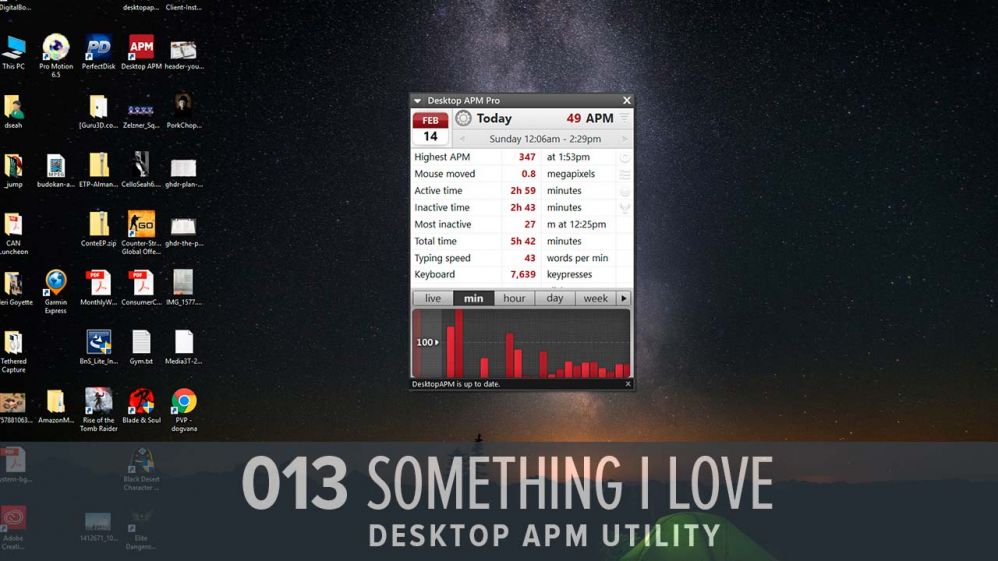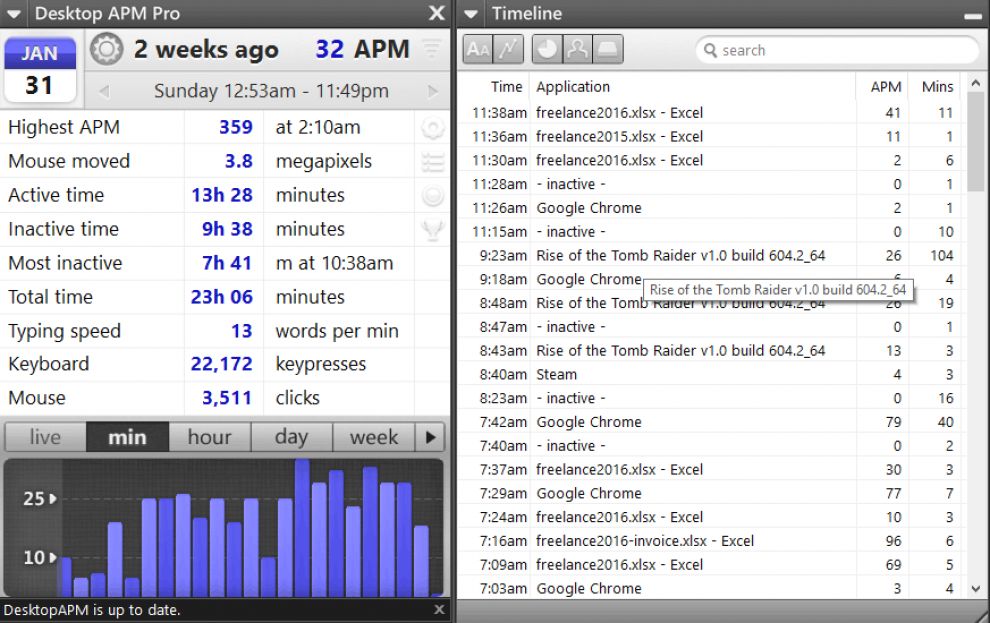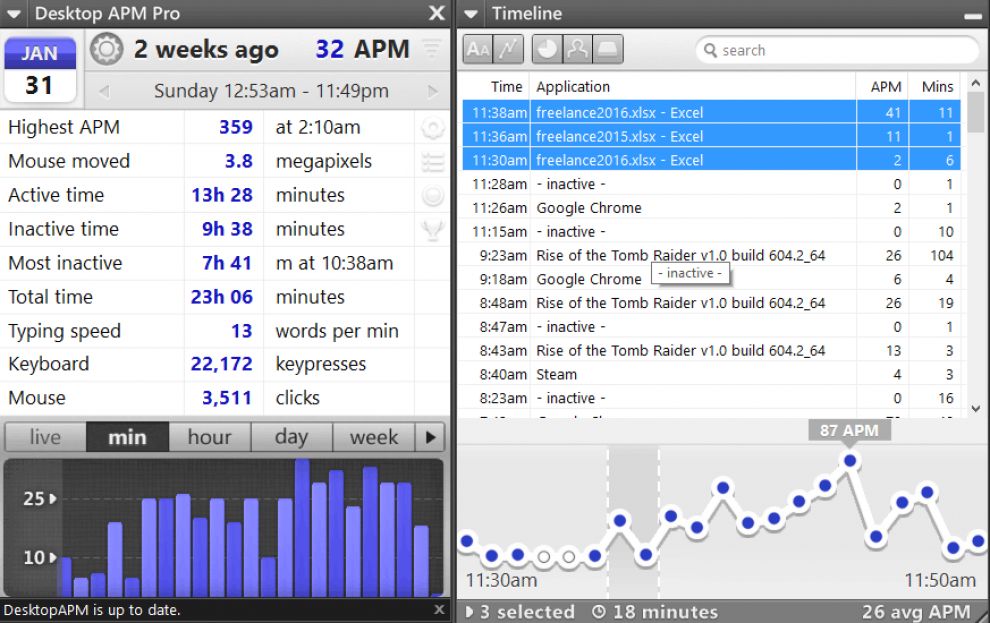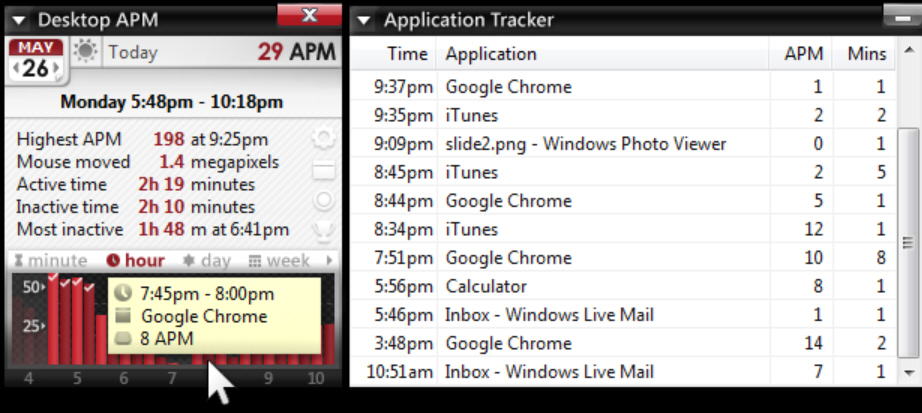Press about Desktop APMSomething I Love: Desktop APM - DavidSeah.com
Being that it's Valentine's Day, I've decided that today's Goal Related Activity will be to share something I love, a little utility called Desktop APM (Windows only). It monitors what applications you have open and measures your "actions per minute" (APM) in terms of keystrokes and mouseclicks, building up a graph over time. It ends up being a helpful "what did I do today?" tool, if you have a single PC that is, and with its graphing capabilities can show you when you were most furiously typing. I came across it when reading about professional gamers competing for huge tournament prizes, and kept coming across the term APM; this video shows how fast a professional gamer is when it comes to pounding out keypresses for the win! Here's what it looks like:
The application runs in the background in a small window that can be dismissed to the task bar. In the screenshot above, the main window is on the left, showing you some stats about your activity. The window on the right is a log of when I was active/inactive in what application; it's a nice log of what I was doing that particular Sunday two weeks ago on the PC. In my case I also have my Macintosh running right next to the PC, so my time is split between them, but for people who might be using a single machine it could function as a complete log. When you click on the listings in the timeline, you get a graph of your APM versus time:
I suppose that this might be useful if you are playing a match in a gaming tournament and wanted to see where your peaks are. Desktop APM has a heatmap feature that also shows where your clicks landed, but it's not very useful outside of gaming. The parts I like most about this utility are really the logging feature and knowing how spazzy I get with my actions-per-minute over the day. Is it really helpful for my productivity? NOT REALLY by itself, but I just like looking at it sometimes. My impression is also that Desktop APM is a tightly-coded utility that targets a very specific niche, and I love those kind of things. Feeling good about what you're doing is part of being productive, after all! And by purchasing the "Pro" version for $4, I am also contributing to a rewards pool for the author to be able to run his own tournament as well as adding more features, which I think is pretty cool! Also, think of how awesome you will feel when you nonchalantly ask someone what their peak APM in Excel is! Oh wait, don't do that. ;-) Check out Desktop APM if you're curious!How busy were you last Tuesday? Desktop APM can help - Betanews
Spend a day on some personal PC task and you'll probably only be interested in the end results. Did you find the information, produce the document, achieve everything you wanted? Go to work on a commercial project, where someone else is paying, and you'll probably want a far more detailed breakdown. Which applications did you use, for how long, and just how much work was involved? Desktop APM is a free-for-personal-use ($3.75 otherwise) tool which can help by tracking exactly where you're spending your PC time. The program works by counting your "Actions Per Minute", mouse clicks and keypresses. It only keeps totals, not the keypresses or mouse positions themselves, and so doesn't have any significant security implications (it's not a keylogger). As these details are collected, the main Desktop APM displays some key statistics. A "Highest APM" figure gives an idea of how busy you've been this session; "mouse moved" shows the distance your mouse has traveled in megapixels; "active time" is the total time you've spent working, while "inactive time" tells you -- well, you get the idea. A simple bar chart shows how your activity has changed over the past few minutes, and there are Hour/ Day/ Week views to give you a more long-term picture. An "Application Tracker" is more interesting, displaying a list of applications, with their APM and the time you spent working in them. The Tracker's report may not be ideal. Applications are listed in order of use, not as a total, so if you kept switching between Word and Chrome then you'll get a separate entry each time. And if you used an application for less than a minute before switching back, that time won't be included at all, at least by default (you can set a lower "Minimum Time In Use"). Still, Desktop APM does at least allow you to copy its text to the clipboard, which means you can paste it into Excel (or wherever) for further analysis. And of course if you typically work in applications for lengthy periods of time, this won't be an issue anyway. The program also has some handy configuration options, covering everything from manually deleting APM histories (if you're concerned about privacy issues) to having the program alert you if you drop below some defined APM figure. Desktop APM may not be the most professional of time trackers, but it's simple, compact and easy to use, with some worthwhile features to explore. Give it a try. |



